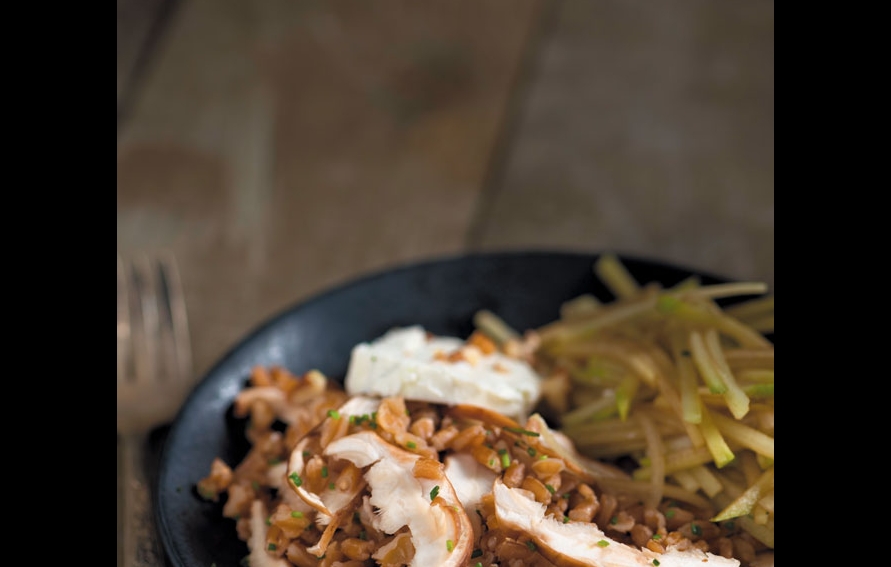Ingredients
- 1 cup farro
- 4 cups good-quality mushroom stock
- 2 tablespoons fresh chives, chopped
- 2 cups shiitake mushrooms, julienned
- 3/4 cup pecan oil
- 1/4 cup balsamic vinegar
- 2 mirlitons, fine julienne
- 6 tablespoons fresh goat cheese (or 4 quarter inch slices from a log)
- 1/4 cup pecans, toasted and chopped
- Salt and black pepper to taste
Instructions
Rinse the farro in water. In a pot set over high heat, bring mushroom stock to a boil. Add farro and a teaspoon of salt and reduce the heat to a simmer. Simmer for 35—40 minutes, until the farro is al dente (retaining some chewiness). Drain, cool and toss with shiitakes and chives. Season with salt and pepper as you find necessary. Cooked farro will keep for 3 days, but the flavor is best on the first day.
Whisk together the pecan oil and balsamic vinegar and season to taste with salt and pepper. Toss the julienned mirliton with dressing to coat (you may have leftover dressing), taste and season with salt and pepper.
Place a large spoonful (about 1/4 cup) farro on each plate. Top with mirliton. Place a disk of goat cheese on top and sprinkle with chopped pecans.
About this recipe
Thirty-five years ago, you were more likely to pick a mirliton from someone's garden than you were to buy the Costa Rican variety available at our supermarkets. Somewhere along the way, perhaps because of the saline waters of Katrina, the strong winds of Gustav, the availability of the gourd year-round at the grocery store or a combination of all three, that traditional variety that grew well in New Orleans was lost.
Our beloved pale green gourd is, of course, pronounced "MEL-uh-tawn" here. It's known as a christophine in the Caribbean, as a chayote in many Spanish- speaking areas and as a "vegetable pear" when a federally funded project in the 1920s tried to introduce it outside Louisiana. The project failed to garner enough interest in the odd gourd and "the mirliton retreated to New Orleans where eccentricity in music, culture and even vegetables were well tolerated," according to Lance Hill, the Mirliton Man.
Hill hunted down a traditional variety after Katrina, one that would grow well in our climate and elevation. Hill's fascinating "A Guide to Growing Mirlitons" on can be found on the Crescent City Farmers Market website.
If you'd like to grow a native variety in your garden, Paul D'Anna is your man. He'll have propagated plants at this year's Mirliton Festival on November 7 at Markey Park in the Bywater. If you miss him there, you can catch him at the Northshore Garden and Plant Sale in 2016 or email him at mailto:LouisianaMirlitons@yahoo.com..
If you've never eaten one raw, you're missing out. Its slightly sweet flavor is laced with refreshing and subtle notes of cucumber. This salad combines some of my favorite fall flavors: nutty farro, sweet mirliton, toasty chopped pecans that mimic the appearance of the farro, and earthy mushrooms. The texture of the mirliton becomes spongier as the vegetable matures, so younger ones work best in this salad.




